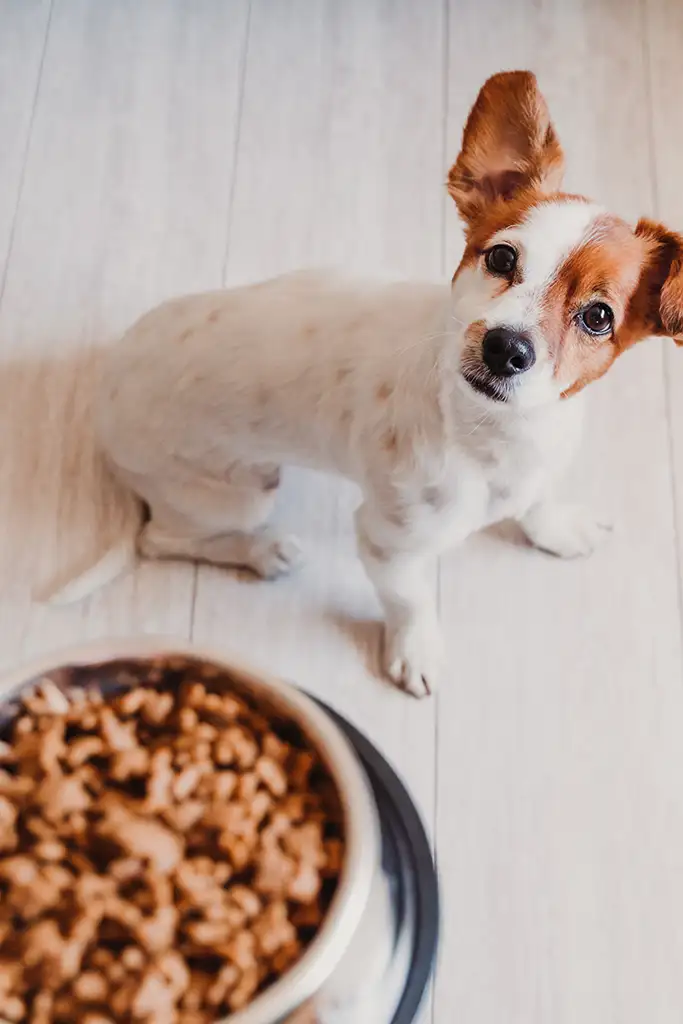Top 7 Recommended Foods for Adult and Puppy Siberian Huskies in 2024
Quick Guide

Famous for their 600-mile run to Nome, Alaska, to bring serum to people dying from diphtheria in 1925, Siberian Huskies are one of the breeds most often associated with sledding. Their thick, dense coat protects them in the cold. The breed is active and athletic and dogs have amazing endurance. They need plenty of daily exercise. In temperament Siberians are friendly, outgoing, gentle, and alert – but not aggressive. They make very good family dogs for active families and they are good with children.
Siberians are medium-sized dogs weighing up to 60 pounds. They come in a wide range of colors from pure white to black. It’s not unusual for Siberians to have various markings on their heads.
The Siberian Husky can have eyes that are brown, blue, black, or a combination of these colors. The dog’s vision is not affected by having different or mixed colored eyes. The typical lifespan of a Siberian is 12 to 15 years.
What is the Best Food for a Siberian Husky?
- Taste of the Wild Pacific Stream Canine Formula with Smoked Salmon
- Ollie Healthy Turkey Feast Fresh Dog Food
- Wellness CORE Grain Free Original Formula
- Canidae All Life Stages Chicken, Turkey, Lamb & Fish Meals Formula
- Wellness Complete Health Puppy
- Earthborn Holistic Puppy Vantage
- Fromm Puppy Gold Formula
General Nutritional Recommendations
All dogs benefit from protein in their diet.Protein supports your dog’s immune system. It helps build lean muscle. It helps your dog have healthy skin and coat. Protein also aids in cellular repair so wounds will heal. This is true for dogs of every age, whether they are growing puppies or senior dogs. The only exceptions occur if your dog has a health issue which requires less protein such as severe kidney failure. Even in the case of kidney disease, the latest research shows that unless your dog has serious kidney problems you shouldn’t have to reduce his protein.
Most canine nutritionists today recommend that dogs have plenty of animal protein in their diet. Dogs are able to digest plant protein, found in ingredients such as peas and lentils, but they can’t digest these ingredients as easily as animal proteins. In addition, if you feed a food that is made up mostly of plant proteins, you will probably have to feed your dog more protein than if he were eating a food that relied on animal protein because the plant protein is not as bioavailable.
Many dog foods today – including many well-known, expensive foods – include lots of plant proteins. Plant proteins are less expensive than most meat proteins so dog food companies often favor them. In some cases ingredients such as peas have been used as a replacement for grains such as corn and wheat which have become objectionable to many dog owners.
Many grain free dog foods contain lots of peas and lentils. They often have high protein percentages. But it’s important to know how much of the protein comes from animal sources and how much comes from plant sources. If the protein in the food is coming mostly from plant sources of protein, your dog may not be able to use it very efficiently, no matter how high the protein percentage on the label. You could be better off feeding a food with a small amount of grain if it has more animal protein.
Should you avoid dog foods that use plant proteins? There’s no need to completely avoid them as long as the food has good sources of animal protein in abundance. Plant proteins can be complementary to animal proteins. If the food lists several good sources of animal proteins among the first ingredients (whole meat proteins, named meat meals), and then lists peas or lentils, the food should be suitable for your dog in terms of protein. On the other hand, if the food relies primarily on plant sources of protein and it’s chock full of peas, lentils, chickpeas, and the like, you should probably look for a better dog food that has more animal protein.
AAFCO (the Association of American Feed Control Officials) recommends that adult dogs such as Siberian Huskies have at least 18 percent protein in their diet. Growing puppies need at least 22 percent protein in their diet.
Most good quality dog foods today far exceed these recommendations. The only foods which are sometimes lower in protein are some hypoallergenic or limited ingredient diet (LID) foods. These foods for dogs with allergies sometimes have to use special meat proteins or plant proteins and the protein percentages are sometimes low. Otherwise, most experts recommend that healthy adult dogs eat a diet that has higher protein percentages, moderate fat, and lower carbs. If your Siberian Husky has any kind of health problem you should check with your veterinarian or a canine nutritionist for advice about his diet.
Good sources of animal protein for your Siberian include meat, eggs, poultry, and fish. These animal sources of protein will provide your dog with all of the essential amino acids he needs.
Your Siberian also needs good quality fat in his diet. While humans often think of fat as something to avoid in our diets, good quality fat is important for your dog. Fat provides a source of energy. Essential fatty acids (EFA) help your dog absorb the vitamins A, D, E, and K. Fatty acids such as omega-3 and 6 support good skin and coat health. As with protein, fats from animal sources are generally better for your dog than fats from plants since your dog can use them more easily. Good sources of animal fat for your dog include salmon oil, fish oil, and chicken fat.
Many dog food companies like to add flaxseed oil to their foods today and claim it is a source of omega-3 fatty acid. This is true but, unfortunately, dogs are not able to use this source of omega-3 very well. Fish oil and salmon oil provide EPA and DHA, the active forms of omega-3. However, flaxseed oil provides omega-3 in the form of alpha linolenic acid (ALA). ALA is an inactive precursor to EPA and DHA. Dogs have difficulty converting ALA to DHA and EPA. This means that flaxseed oil is not very useful to dogs as a source of omega-3.
Adult dogs need a minimum of 5 percent fat in their diets, according to AAFCO. Puppies need a minimum of 8 percent fat. Puppies grow fast during their first year, especially during the first few months. They use up lots of energy during this time and need plenty of calories. Their need for calories gradually tapers off during the first year until they are eating at adult levels by the time they are about a year old. The fatty acids EPA and DHA are especially important for puppies. They help with brain and eye development. Many good quality puppy foods now include these fatty acids in their formulas.
It’s unlikely that you will need to worry about these minimum fat percentages in dog and puppy foods. Virtually all dog and puppy foods today have higher fat percentages than these minimums. The only exceptions are some weight loss dog foods that can have low fat percentages and low calories. These foods are usually maintenance dog foods. They should never be fed to puppies. It’s more likely that you will need to watch for fat percentages that are too high. Some dog foods today have very high fat percentages. This is especially true with canned foods.
Most healthy dogs, living a pet lifestyle and not doing any serious work, should eat a food that has a fat percentage that is about half of the food’s protein percentage. For example, if your dog food has a protein percentage of 26 percent, a fat percentage of about 13 percent would be suitable. Dog foods that have between 12 and 16 percent fat (dry matter basis) are generally considered to be moderate in fat by dog food standards today. Dog foods with a protein percentage between 24 and 32 percent (DMB) are usually considered suitable for most healthy adult dogs. There are many good quality dog foods that meet these recommendations.
You often see comments from people stating that dogs don’t “need” carbohydrates. This is not really accurate. People talk about what wolves ate, ancestral diets, etc. First, your dog isn’t a wolf. Your dog doesn’t have the same digestive system as a wolf. Proto-dogs and now dogs have lived with humans for many thousands of years and they have adapted to eating what we feed them, which does include carbohydrates. Second, most foods are not 100 protein, or 100 percent fat, or 100 percent anything. Look at the nutritional data for most ingredients and you will see that foods provide varying amounts of protein, fat, carbs, vitamins, and minerals. Want to feed your dog goat meat? A lot of it is fat. Want to feed your dog chickpeas? They are almost 70 percent carbohydrates. One food can provide lots of different nutrients. Your dog can get lots of nutrients from different foods. Even if you are trying to avoid carbohydrates, your dog is probably getting some in his diet. Carbs don’t have to come from corn and wheat. They come from all kinds of foods.
Many dog owners don’t like the idea of carbohydrates in dog foods because so many foods have used poor quality carbs as filler ingredients in the past. This is undeniable. Some of these ingredients, such as corn, have done double-duty as plant sources of protein, too, making them even less desirable. But that doesn’t mean that all carbohydrates are bad for your dog. They are an important source of energy. Some carbohydrates also help to digest other nutrients in the body. You probably know them as prebiotics and dietary fiber. Rice, corn, sweet potatoes, potatoes, lentils, and peas all contain lots of complex carbohydrates. None of these ingredients have to be used as filler ingredients or as replacements for meat protein. Used in small amounts they can be good additions in a dog food. Fruits and vegetables can also provide carbohydrates in a dog food. Chicory and beet pulp – both carbohydrates – are often added to dog food as prebiotics.
Insoluble carbohydrates are a source of fiber in dog foods that can help with digestion. This fiber doesn’t break down in your dog’s gut but it does absorb water. It helps your dog feel full and it moves matter along the gastrointestinal tract. Too much of this fiber can lead to loose stools and flatulence but many foods include some of these insoluble carbohydrates in their formulas today. Large amounts of fiber are most often found in weight control dog foods or in lower quality foods. Most kibbles today have between 3.3 and 6 percent (DMB) fiber.
As for the overall percentage of carbohydrates in kibble today, it can range from 30 to 50 percent, or more. Pet food manufacturers are not required to provide this information but you can check reviews on Pawster. You can also contact the company directly for the most accurate carbohydrate figures but not all companies are forthcoming. Most experts recommend that a good dog food should not have more than 20 to 30 percent carbohydrates. Unfortunately, it can be hard to find dog foods with a carb percentage this low. We suggest looking for foods that are low to moderate in carbohydrates – but don’t be too surprised if many of the foods you like have carb percentages that are somewhat higher. Even some of the best dog foods today have carb percentages that are higher than you might expect after you do the math. A certain amount of carbohydrates/starch is unavoidable in kibble since it’s necessary to hold the dog food batter/dough together and send it through the machinery but most kibbles have more than you would imagine.
Your Siberian Husky also needs certain vitamins and minerals in his diet. While it’s nice to think that your dog can get all of his vitamins and minerals from the food ingredients in his dog food, most pet foods are cooked at such high temperatures (and heated multiple times) that nutrients can be lost during the cooking process. To make up for this loss, dog food companies add vitamins and minerals to the food. Many companies source some of their vitamins and minerals from countries outside the U.S. such as Canada, France, China, and elsewhere. Lots of people are concerned about ingredients sourced from China, including vitamins and minerals. You can often find this information on a company’s web site (check the FAQ section). Or contact the company directly. For some minerals there may be few options about sources but you should let a company know if you have concerns.
Many dog foods today also include probiotics or digestive enzymes (“fermentation products”) for healthy digestion. These are noted in the ingredient list.
We recommend that you avoid foods that contain artificial colors, flavors, and sweeteners, as well as artificial preservatives. Artificial preservatives include ethoxyquin, butylated hydroxyanisole (BHA), butylated hydroxytoluene (BHT), tert-butyl hydroquinone (TBHQ), and propyl gallate. Vitamin E, Vitamin C, and certain plant extracts such as rosemary oil are often used as natural preservatives. Natural preservatives will not keep a food fresh as long as artificial preservatives but they are considered to be a healthier option for your dog.
What is the Best Dog Food for My Siberian Husky?
Most good quality dog foods today are formulated to be good for all dogs. You can look for foods that are AAFCO-approved for “All life stages.” This would be a good place to start when looking for foods for your Siberian Husky, regardless of his age. These foods are suitable for puppies, adults, and for senior dogs. As with any food, you should check the calories and pay attention to your dog’s condition. See if he’s gaining or losing weight while he eats the food. Monitor the portion size you feed and how much your dog is eating so he doesn’t become overweight.
You can also look for foods that are specially formulated for your dog’s life stage such as puppy formulas or adult maintenance dog foods.
Here are some good foods that we like for adult Siberian Huskies:
Taste of the Wild Pacific Stream Grain-Free Dog Food
Healthy Ingredients : Salmon, Ocean Fish Meal, Sweet Potatoes, Potatoes, Peas
Key Features :
- Antioxidants for immune support
- Helps to keep coat shiny
- Grain-free
- Fat and calories suitable for active dogs
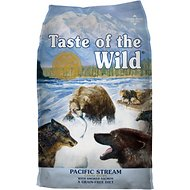
Taste of the Wild Pacific Stream Grain-Free Dog Food
Taste of the Wild Pacific Stream Grain-Free Dog Food is a great choice for your Husky. It has salmon as the first ingredient and main source of protein and it is grain free and has no artificial flavors or preservatives.
Taste of the Wild Pacific Stream formula is a grain free food with a crude protein percentage of 25 percent. It has a crude fat percentage of 15 percent and 360 kcal/cup. The first five ingredients in this food are: salmon, ocean fish meal, sweet potatoes, potatoes, and peas. If your Siberian likes fish, he should like this food. This formula also has antioxidants, digestive enzymes, pre- and probiotics, chelated minerals, and natural preservatives. Taste of the Wild has a variety of other kibble and canned formulas, many with higher protein and fat percentages, if your dog doesn’t like the Pacific Stream formula. Taste of the Wild generally offers good quality dog foods at a moderate price. Do pay attention to the fat percentages in their foods. They tend to be a little high compared to the protein percentages – but most dogs won’t complain. Many dog owners are happy feeding Taste of the Wild and most dogs like the foods.
Ollie Healthy Turkey Feast Fresh Dog Food
Healthy Ingredients : Turkey breast, turkey liver, kale, carrots, lentils
Key Features :
- Human-Grade
- Subscription-based
- Portioned Individually for your dog
- Auto-ships direct to your door
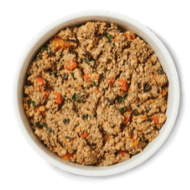
Ollie Healthy Turkey Feast Fresh Dog Food
Ollie Healthy Turkey Feast Fresh Dog Food is a fresh, human-grade dog food option that is delivered to your doorstep based on your subscription and your dog’s needs. It is slow-cooked in small batches and can be stored in your fridge or freezer.
If you are looking for a high quality food for your pet, considering a fresh food option is a great place to start. Ollie dog food is considered human-grade and is delivered fresh to your doorstep based on a delivery schedule chosen by you. Although it can be a bit pricey compared to regular dog food, it has a lot of great benefits for keeping your dog healthy and active. They have a few different recipes to choose from. The particular recipe shown in the table above includes carrots (which are full of phytonutrients for eye health), blueberries (which are high in antioxidants), and chia seeds which are a source of copper, zinc, and manganese. The foods are cooked slowly to preserve nutrients and they don’t use any preservatives or fillers. They also include super foods such as chia to help support your pet’s active lifestyle. You can rest-assured, when feeding your dog Ollie, that you are choosing a premium food.
Wellness CORE Grain Free Original Formula
Healthy Ingredients : Deboned Turkey, Turkey Meal, Chicken Meal, Peas, Potatoes
Key Features :
- Supports joint and coat health
- Maintenance dog food
- No grains
- Wide variety of vegetables
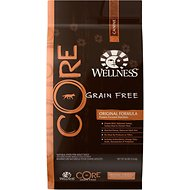
Wellness CORE Grain Free Original Formula Dog Food
Wellness CORE Grain Free Original Formula is a maintenance dog food that is high in protein and supportive of joint health and a healthy coat.
Wellness CORE Grain Free Original Formula is a maintenance dog food so it’s not appropriate for puppies but it’s a good choice for adult Siberian Huskies. The food is high in protein with 34 percent crude protein. It is moderate in fat with 16 percent crude fat. It has 421 kcal/cup. The first five ingredients in the food are deboned turkey, turkey meal, chicken meal, peas, and potatoes. This formula has no meat by-products or fillers. It contains no artificial flavors or preservatives. This recipe includes glucosamine and chondroitin for joint health; probiotics and fiber for good digestion; and omega fatty acids for healthy skin and coat. Wellness Core Grain Free Original Formula has no grains, as the name suggests. The food does contain a wide variety of vegetables which add some carbohydrates and plant material to the food. This formula is gluten-free and it has no corn, wheat, or soy. If your dog doesn’t like this formula, Wellness CORE also makes other kibble recipes as well as some canned foods. You may also want to consider the Wellness Complete Health line of dog foods, made by the same company. The protein percentages in the Wellness Complete foods are a little lower.
Canidae All Life Stages Chicken, Turkey, Lamb & Fish Meals Formula
Healthy Ingredients : Chicken Meal, Turkey Meal, Lamb Meal, Brown Rice, White Rice
Key Features :
- No corn, wheat, or soy
- Good source of dietary fiber
- Great for all life stages
- Pro and prebiotics
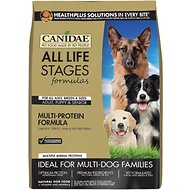
Canidae All Life Stages Chicken, Turkey, Lamb & Fish Meals Formula
Canidae All Life Stages Chicken, Turkey, Lamb & Fish Meals Formula is a great choice for your Husky because it is for all stages, it is a good source of dietary fiber, and it does not contain corn, wheat, or soy.
We think that Siberian Huskies would do well eating Canidae All Life Stages Chicken, Turkey, Lamb & Fish Meals Formula dog food. This is an all life stages food so you can feed it to dogs of any age from puppies to seniors. The first five ingredients in the food are: chicken meal, turkey meal, lamb meal, brown rice, and white rice. This Canidae formula does contain rice, oatmeal, and barley but even if your dog has problems with corn or wheat, most dogs can eat these grains without any trouble. Oatmeal and barley are good sources of dietary fiber. This food does not contain any corn, wheat, or soy. It has natural preservatives and it has pre- and probiotics to help with digestion. It also has omega-3 and 6 fatty acids to keep your Siberian’s skin and coat healthy. The food has 24 percent crude protein and 14.5 percent crude fat, with 468 kcal/cup. If you’re looking for a food with good ingredients, with moderate protein and fat, this would be a good food for your Siberian Husky.
What is the Best Food for Siberian Husky Puppies?
As with other puppies, Siberian Husky puppies should be encouraged to grow slowly and stay slim. A good puppy food should provide plenty of calories and energy for your puppy without over-doing it.
Wellness Complete Health Puppy
Healthy Ingredients : Deboned Chicken, Chicken Meal, Oatmeal, Ground Barley, Salmon Meal
Key Features :
- No corn, wheat, or soy
- Good source of protein
- DHA for brain development
- Omega fatty acids for skin and coat health
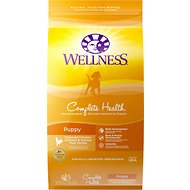
Wellness Complete Health Puppy Food
Wellness Complete Health Puppy has DHA to help with your growing puppy’s brain development and it is a great source of protein and complex carbs. It has no corn, wheat, or soy.
Wellness Complete Health Puppy formula is a good choice for many Siberian Husky puppies. The first five ingredients are: deboned chicken, chicken meal, oatmeal, ground barley, and peas. It contains no corn, wheat, or soy. The ingredients in this formula are easy for puppies to digest. DHA helps with brain and eye development. Vitamin A and calcium help your puppy have healthy eyes and teeth. And omega fatty acids from salmon oil help your puppy’s skin and coat stay healthy. This food has 29 percent crude protein and 18 percent crude fat with 450 kcal/cup. This food can provide plenty of energy for your active Siberian puppy. Wellness also makes a grain free food for puppies, as well as adult dog foods.
Earthborn Holistic Puppy Vantage
Healthy Ingredients : Chicken Meal, Whitefish Meal, Oatmeal, Ground Barley, Ground Brown Rice
Key Features :
- Calcium for bone development
- Protein packed
- Complex carbs
- Easy to digest
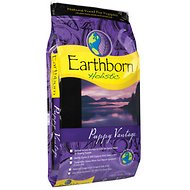
Earthborn Holistic Puppy Vantage
Earthborn Holistic Puppy Vantage is a good choice for your puppy. It has DHA for healthy brain and eye development and omega 6 and 3 for skin and coat health. It also has a great balance of calcium and phosphorus for bone development.
Earthborn has lots of popular adult dog food formulas but Earthborn Holistic Puppy Vantage is their only puppy formula. This food gets great reviews from just about everyone who feeds it to their puppy. It has DHA for healthy brain and eye development; balanced omega-6 and omega-3 for good skin and coat; and nutrient-rich carbohydrates such as sweet potatoes, oatmeal, barley, and brown rice that are easy for your puppy to digest. It also has the right balance of calcium and phosphorus for your puppy’s bone development. The first five ingredients in this food are: chicken meal, whitefish meal, oatmeal, ground barley, and ground brown rice. The food has 28 percent crude protein and 20 percent crude fat. It has 32 percent carbohydrates (thanks for providing that information, Earthborn). This food has 445 kcal/cup. This looks like an excellent puppy food for Siberian Husky puppies.
Fromm Puppy Gold Formula
Healthy Ingredients : Duck, Chicken Meal, Chicken, Oatmeal, Pearled Barley
Key Features :
- DHA for brain and eye health
- Encourages slow growth
- Calcium and phosphorus for bone health
- Specially formulated for puppies
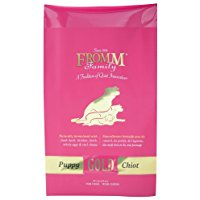
Fromm Puppy Gold Formula Dog Food
Fromm Puppy Gold Formula< has moderate protein and fat levels to help your puppy grow at the right pace. It has salmon oil for added DHA to help with brain and eye development./p>
View Latest Price
Fromm Puppy Gold Formula is popular with many breeders. The first five ingredients in the food are: duck, chicken meal, chicken, oatmeal, and pearled barley. It has moderate protein and fat levels to encourage puppies like Siberian Huskies to grow slowly. The food has 27 percent crude protein and 18 percent crude fat, with 417 kcal/cup. You can see the technical analysis for the food on the Fromm web site here. This is a good way to check the calcium and phosphorus levels in a puppy food to make sure they are appropriate. The Fromm Puppy Gold formula also has salmon oil which adds DHA for your puppy’s brain and eye development.

Special Dietary and Nutritional Considerations
According to many people who breed and own Siberian Huskies, many of these dogs are lacose-intolerant. You should avoid giving your Siberian milk and other dairy products. Some dairy products have more lactose than others. In general, milk, ice cream, yogurt, and cottage cheese are high in lactose. Some cheeses, such as Cheddar, are very low in lactose so you may be able to give your Siberian small amounts of this cheese as a treat.
Some breeders and owners also report that Siberians digest food very efficiently. For this reason they sometimes eat less food than other breeds. Some Siberians skip meals because they aren’t hungry. As long as your Siberian Husky is not going more than a day without eating, and he’s not losing weight, this is not unusual for the breed.
You can find recommended feeding amounts on the labels of dog foods but these amounts are based on very general figures for all dogs. You can calculate the exact calories your dog needs using these charts and tables. A medium-sized breed like the Siberian Husky usually needs about 30 calories per pound/per day but other factors will also affect how much you feed your dog. These factors include his activity level, whether he’s neutered, his age, and so on. For example, a dog that is spayed/neutered usually needs fewer calories per day because these dogs will have a slower metabolism. If your Siberian Husky is very active – maybe he’s jogging with you or training for agility competitions – he will need more calories. A typical Siberian who weighs 50 pounds will need about 1312 calories per day. If the same dog is doing daily training for agility or another dog sport, he might need around 2186 calories per day or more. You can adjust your dog’s calories up or down depending on his physical condition and whether he’s gaining or losing weight.
Siberian Husky puppies grow quickly for the first few months of life. They will need a good quality puppy food after they are weaned with plenty of calories. They still need lots of calories after that time but their growth starts to slow until they become adults. You can use this chart as a guideline for how many calories your puppy needs at different stages and weights. If you aren’t sure about your puppy’s weight, remember that it’s better for a puppy to stay slim. Hip dysplasia is rare in Siberian Huskies but it’s still a good idea to encourage slow growth. If you have questions about your puppy’s weight and condition, check with your puppy’s breeder or your veterinarian.
Like all dogs, Siberian Huskies will do well eating a dog food that is made of good quality ingredients. Look for a food that is complete and balanced with good nutrition.
| Siberian Husky Dog Food Comparison Table | |||
| Rank | Product | Price | Rating |
| Best Overall |
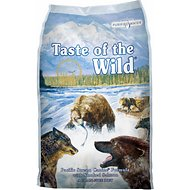 Taste of the Wild Pacific Stream Canine Formula with Smoked Salmon | $1.63/lb |
A
|
| Human Grade |
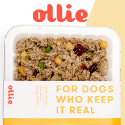 | Varies |
A+
|
| #1 |
 | $2.30/lb |
A+
|
| #2 |
 Canidae All Life Stages Chicken, Turkey, Lamb & Fish Meals Formula | $1.30/lb |
A
|
| #3 |
 | $1.73/lb |
A
|
| #4 |
 | $1.23/lb |
A
|
| #5 |
 | $5.96/lb |
A
|

Conclusion
These are only a few suggestions for your Siberian Husky. There are lots of good dog and puppy foods today. What really matters is finding a food that meets your dog’s nutritional needs. Take the information provided here and use it when selecting a dog food. If you need some help, start with one of the foods recommended here or look at some of the foods we have reviewed on Pawster.











